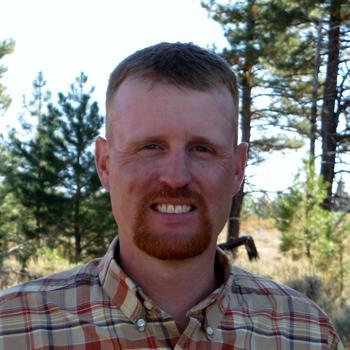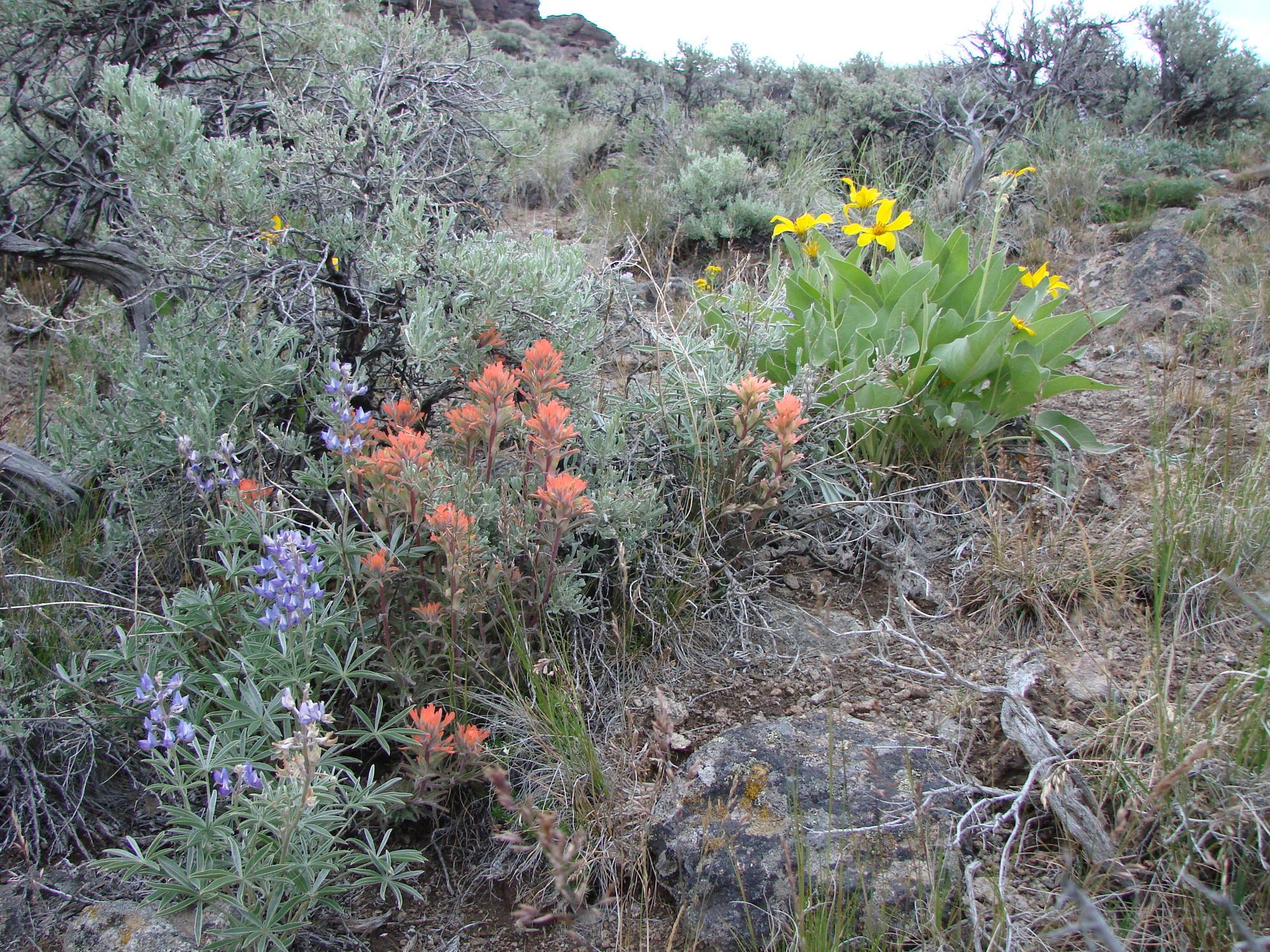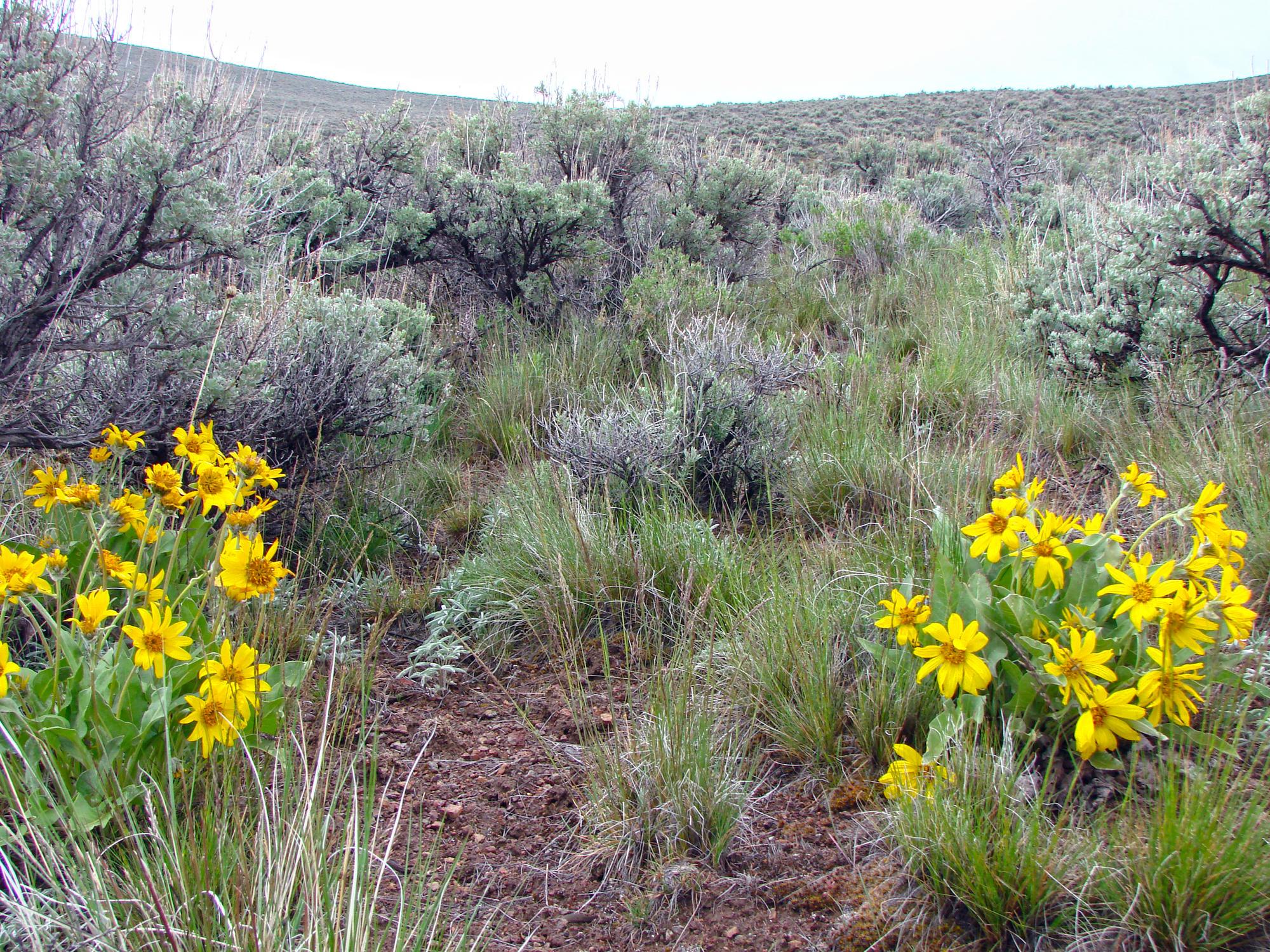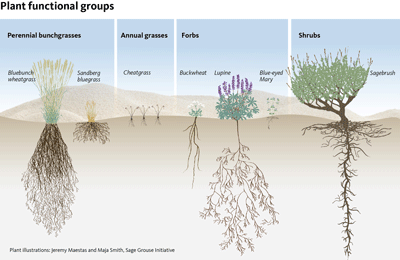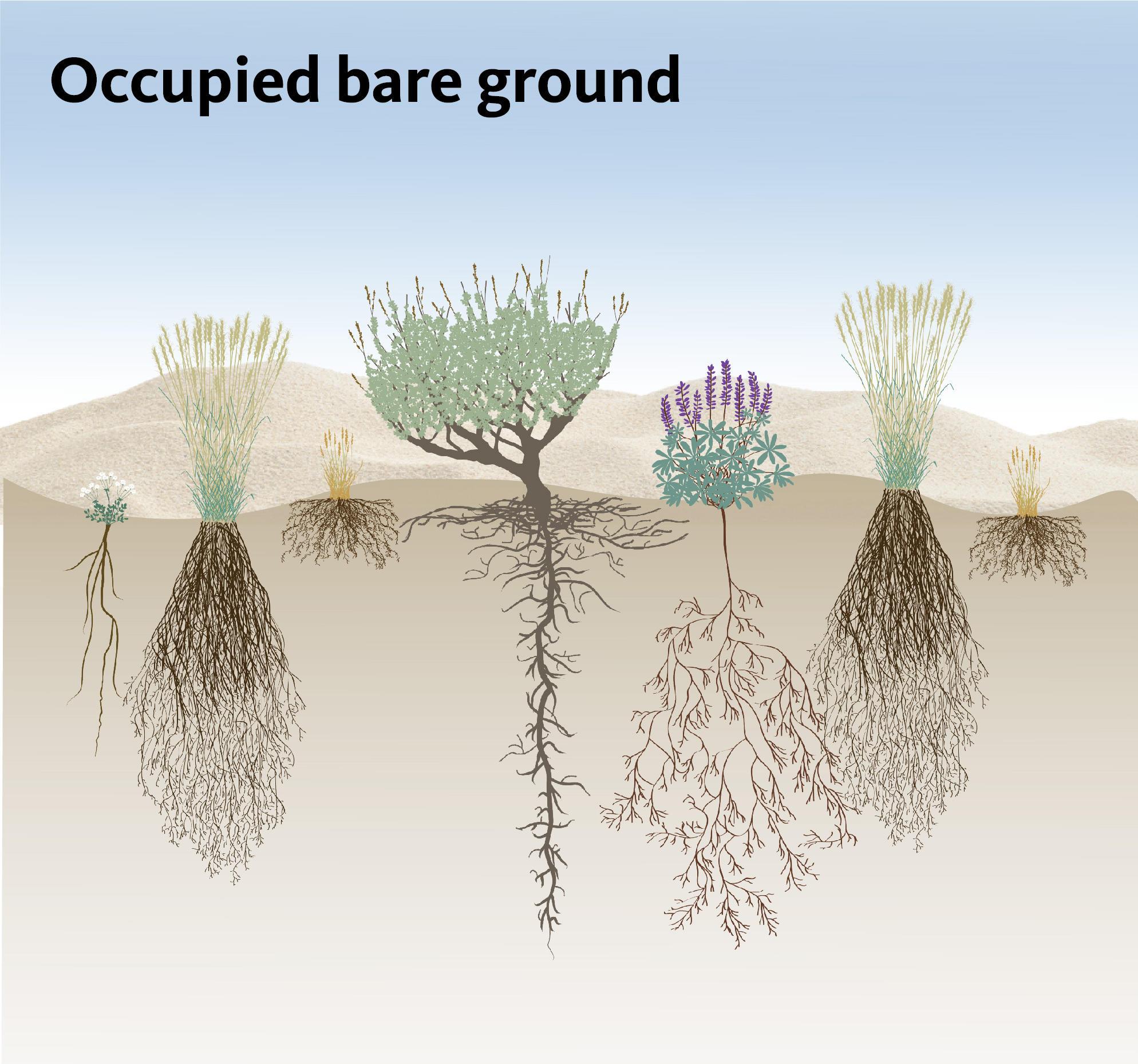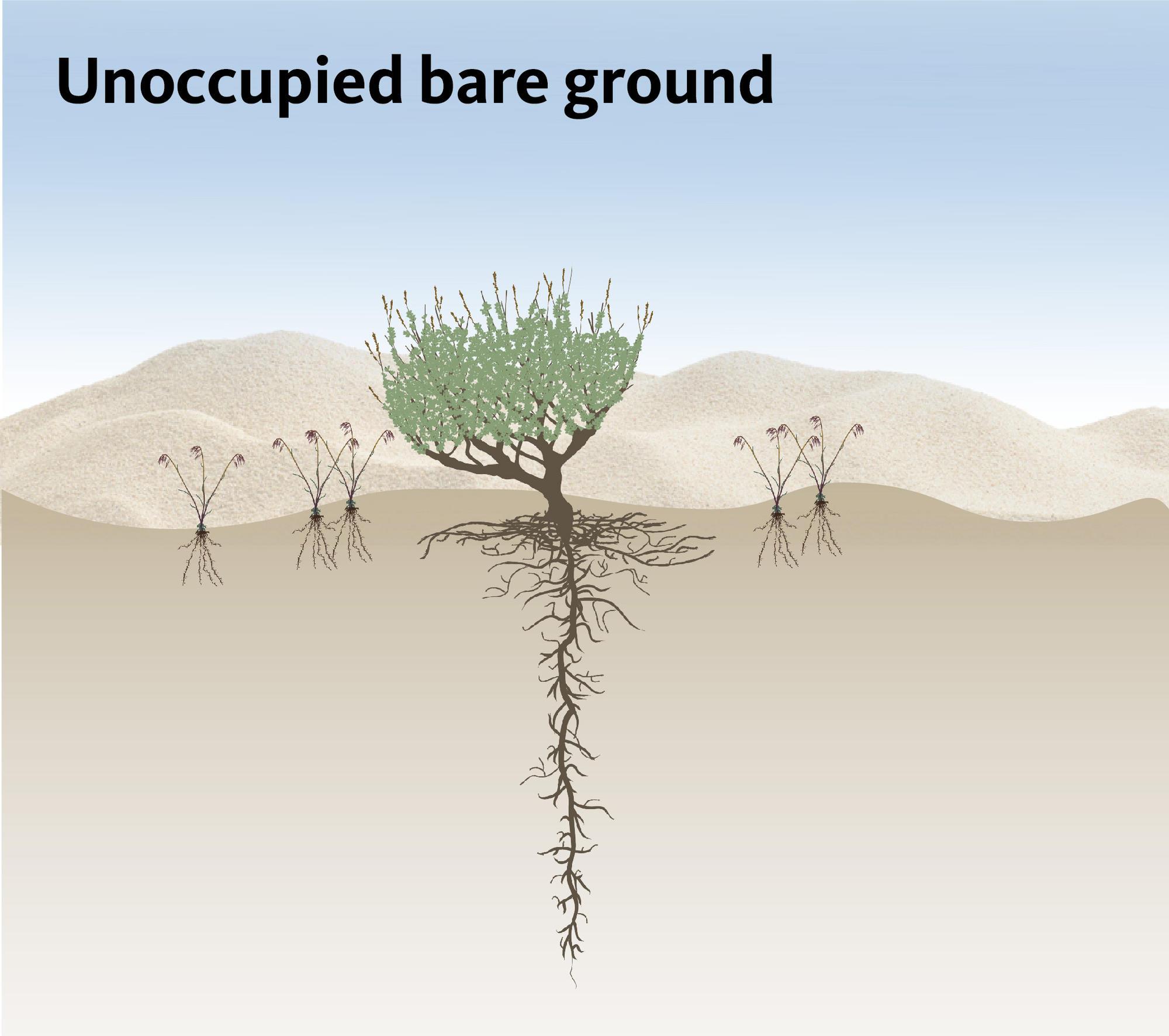Look out at a view of the sagebrush steppe, and you may see what looks like a sea of sagebrush. But a closer, deeper look shows a diverse ecosystem with a wide variety of plants and animals.
Variation abounds within this complex plant community, over both time and space. At different points in the season, fluctuations in temperature and moisture may promote expression of different species of plants. Species also vary across elevation gradients and soil types.
Hundreds of plant and animal species call the sagebrush steppe home, and plant species diversity varies dramatically, with 25 to 50 different species inhabiting many sites.
The two plant communities pictured in figures 1 and 2 demonstrate some of this variation. Both are pictures of healthy sagebrush steppe sites; however, Figure 1 features a greater diversity of species than Figure 2.
These diverse sagebrush steppe ecosystems are under threat from large-scale disturbances and the invasion of undesirable species. For example, settlement of the western sagebrush steppe and mismanagement of livestock grazing in the late 1800s and early 1900s brought an invasion of annual grasses and an unprecedented rise in wildfire magnitude and intensity. These threats play an important role in understanding the ecology and management of the sagebrush steppe ecosystem.
Vegetation functional groups
With hundreds of species and vast variation, tracking patterns and trends in individual plant species proves ineffectual for the ecosystem as a whole. Grouping plant species together by similar features, or functions, provides a more informative approach to assessing rangeland health. These “functional groups” usually are broken down into deep- and shallow-rooted perennial bunchgrasses; annual grasses; annual and perennial forbs; and shrubs.
Niches
Each functional group fills a particular niche within an ecosystem. Each of the different plant types in the sagebrush steppe has unique rooting systems that are adapted to access water and nutrients from different parts of the soil profile. Sandberg bluegrass, a common, perennial bunchgrass, has a shallow, spreading rooting system designed to take advantage of soil moisture in the spring after snowmelt and rains. Most of the roots of this grass exist in the top 6 inches of the soil, and it lacks deeper roots needed to grow longer into the summer. In contrast, perennial bunchgrasses have a high density of shallow, lateral, and deeper roots to access the soil moisture and nutrients throughout the soil profile and can grow through the summer.
Perennial bunchgrasses have the highest root mass among the plant types and most effectively take nutrients and water from the soil, reducing available resources for invasives.
Bare ground
With completely filled niches, healthy sagebrush steppe will often consist of bare ground areas that appear empty. This high desert ecosystem usually receives less than 12 inches of precipitation a year. Fewer plants can grow in this limited environment than in areas with higher annual precipitation. This limit on water resources leads to areas of bare ground even in sites with completely filled niches, as shown in figures 1 and 2.
In healthy range, scientists call bare areas occupied bare ground (Figure 4). It might appear to be bare and unused, but beneath these bare areas, the soil profile is occupied by the roots of perennial plants that are taking up nutrients and water and making those resources unavailable to undesirable invasive annual grasses. The above-ground area around bunchgrasses might appear barren, but by taking an underground view, it becomes obvious the plants’ root masses fully utilize that space.
Conversely, in plant communities where bunchgrasses are reduced or lacking, niches are left unfilled, and we find unoccupied bare ground (Figure 5). These areas are open to invasion by undesirable plants.
Changing communities
Our ecosystems are not static; plant communities change over time. Range management is not intended to force the land back to a rigid community identical to the one that existed before European settlement. Instead, we want our communities to be composed of native species that are both resistant to threats and resilient to disturbance.
Through the lens of change we can view the threats of today compared to the past. Historically, disturbances such as fire made sites available for native species to reestablish themselves. The surviving seed bank and nearby native species provided the necessary propagules (such as native seeds), to fill the open sites. Before European settlement, our long-lived perennial bunchgrasses could take their time re-establishing; they could wait for ideal conditions that might come once a decade. Today, if disturbance increases, as in the case of more frequent fires, our native grasses and shrubs might never get the chance to fully establish. These plant communities are neither resistant to fire nor resilient against invasive plants.
Invasive annual grasses
Historically, native species could afford to wait for a favorable time to establish, but today the available species are not limited to natives. They now include invasive annual grasses, such as cheatgrass, ventenata and medusahead rye, which are highly competitive with establishing bunchgrasses and exert high propagule pressure on the disturbed sites waiting to be occupied. If natives do not capitalize on site availability immediately, the annuals fill the sites, outcompeting native seedlings.
Annual grasses evolved to thrive in disturbed, high-nutrient environments. They use a “get-rich-quick” strategy, investing all their energy into rapid growth and seed production before conditions dry out in the summer. When perennial bunchgrasses are lost from sagebrush steppe plant communities, invasives often fill the available sites, the number of natives decreases, and the community shifts to a new state: one dominated by annual grasses. This more fire-prone state consists of dense annuals that cure quickly in the summer, providing continuous, dry fuel for wildfire to spread. This creates a positive feedback loop in which the annuals alter the environment to their advantage. What once was a perennial community with burns every 50 to 150 years becomes an annual community with burns every one to five years.
In order to break this fire-annual grass cycle, we must work to conserve and promote bunchgrasses in the sagebrush steppe.
Icebergs in the sagebrush sea
The optimum management strategy for promoting rangeland function and productivity includes preventing the loss of established perennial bunchgrasses. The more bunchgrasses on a landscape, the less unoccupied bare ground, and the higher resistance the site has to disturbance and invasion. The deep-rooted perennial bunchgrasses are the icebergs of the range. They have most of their resources invested underground, and are the most important functional group for preventing invasion by undesirable annual species. Bunchgrasses also improve the resilience of the ecosystem to wildfire. The deep roots allow bunchgrasses to regrow after fire. This regrowth prevents open niches and unoccupied bare ground, reducing the potential for conversion to an annual grassland.
The overarching objective for range management is simple: We want the rooting profile of the soil to be fully occupied by the roots of healthy, noninvasive plants.
Glossary
- Annuals: plants that grow from seed and then die, completing their life cycle within a year
- Perennials: plants that use energy stores to come back year after year
- Resistance: the ability of an ecosystem to remain unchanged in the face of disturbance
- Resilience: the ability of an ecosystem to respond to a disturbance by rapidly recovering
- Unoccupied bare ground: bare ground with available resources, ripe for invasion
- Occupied bare ground: bare ground in which all resources are fully utilized
- Propagules: parts of an organism, such as a seed, that propagate, or produce a new individual

